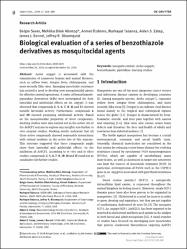| dc.contributor.author | Sever, Belgin | |
| dc.contributor.author | Altıntop, Mehlika Dilek | |
| dc.contributor.author | Özdemir, Ahmet | |
| dc.contributor.author | Tabanca, Nurhayat | |
| dc.contributor.author | Estep, Alden S. | |
| dc.contributor.author | Becnel, James J. | |
| dc.contributor.author | Bloomquist, Jeffrey R. | |
| dc.date.accessioned | 2019-10-19T14:44:46Z | |
| dc.date.available | 2019-10-19T14:44:46Z | |
| dc.date.issued | 2019 | |
| dc.identifier.issn | 2391-5420 | |
| dc.identifier.uri | https://dx.doi.org/10.1515/chem-2019-0027 | |
| dc.identifier.uri | https://hdl.handle.net/11421/13607 | |
| dc.description | WOS: 000475786600001 | en_US |
| dc.description.abstract | Aedes aegypti is associated with the transmission of numerous human and animal diseases, such as yellow fever, dengue fever, chikungunya, and more recently Zika virus. Emerging insecticide resistance has created a need to develop new mosquitocidal agents for effective control operations. A series of benzothiazole-piperidine derivatives (1-24) were investigated for their larvicidal and adulticidal effects on Ae. aegypti. It was observed that compounds 2, 4, 6, 7, 8, 11 and 13 showed notable larvicidal activity. Furthermore, compounds 6 and 10 showed promising adulticidal activity. Based on the mosquitocidal properties of these compounds, docking studies were also carried out in the active site of the AeSCP2 enzyme to explore any insights into further in vitro enzyme studies. Docking results indicated that all these active compounds showed reasonable interactions with critical residues in the active site of this enzyme. This outcome suggested that these compounds might show their larvicidal and adulticidal effects via the inhibition of AeSCP2. According to in vitro and in silico studies, compounds 2, 4, 6, 7, 8, 10, 11 and 13 stand out as candidates for further studies. | en_US |
| dc.description.sponsorship | Deployed War-Fighter Protection Research Program; U.S. Department of Defense through the Armed Forces Pest Management Board | en_US |
| dc.description.sponsorship | This study was partly funded by the Deployed War-Fighter Protection Research Program via grants from the U.S. Department of Defense through the Armed Forces Pest Management Board (to JJB and to JRB). We thank Miss Jessica Louton (USDA-ARS, CMAVE, Gainesville, FL) for mosquito bioassays. Mention of trade names or commercial products in this publication is solely for the purpose of providing specific information and does not imply recommendation or endorsement by the U.S. Department of Agriculture or the U.S. Department of Defense. USDA is an equal opportunity provider and employer. | en_US |
| dc.language.iso | eng | en_US |
| dc.publisher | Sciendo | en_US |
| dc.relation.isversionof | 10.1515/chem-2019-0027 | en_US |
| dc.rights | info:eu-repo/semantics/openAccess | en_US |
| dc.subject | Mosquito Control | en_US |
| dc.subject | Aedes Aegypti | en_US |
| dc.subject | Benzothiazole | en_US |
| dc.subject | Piperidine | en_US |
| dc.subject | Docking Studies | en_US |
| dc.title | Biological evaluation of a series of benzothiazole derivatives as mosquitocidal agents | en_US |
| dc.type | article | en_US |
| dc.relation.journal | Open Chemistry | en_US |
| dc.contributor.department | Anadolu Üniversitesi, Eczacılık Fakültesi, Farmasötik Kimya Anabilim Dalı | en_US |
| dc.identifier.volume | 17 | en_US |
| dc.identifier.issue | 1 | en_US |
| dc.identifier.startpage | 288 | en_US |
| dc.identifier.endpage | 294 | en_US |
| dc.relation.publicationcategory | Makale - Uluslararası Hakemli Dergi - Kurum Öğretim Elemanı | en_US |
| dc.contributor.institutionauthor | Sever, Belgin | |
| dc.contributor.institutionauthor | Altıntop, Mehlika Dilek | |
| dc.contributor.institutionauthor | Özdemir, Ahmet | |


















